This week on the Naked Scientists, we delve into the secrets of the universe to find out what we're really made of. Ben Allanach explains how a particle accelerator actually works and what it can tell us about the Big Bang.& Naked Scientist Meera Senthilingam puts on her sunglasses to visit a light source 10 billion times brighter than the sun. And finally, we're joined by Cristina Lazzeroni, to discuss her "beautiful" investigations at a subatomic level.
In this episode
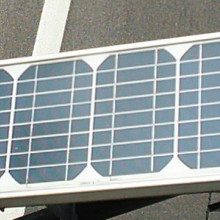
World's smallest solar panel, or should that be wire?
US scientists have taken solar cell technology a step further with the development of the solar nanowire - a solar device 200 times smaller than a human hair.
Charles Lieber and his team at Harvard in the US have found a way to deposit the three semi-conductor layers needed to make a solar cell in concentric circles. The innermost layer consists of silicon containing a small amount of boron, which makes it eager to give up electrons. A thin insulating "shell" of plain silicon is then deposited around the inner core, and an outer layer of silicon "doped" with electron-hungry phosphorus is added around the outside.
 When light hits the wire it knocks electrons off the boron and into the phosphorus-containing outer shell. They then flow around a circuit to return to their starting point. Under normal sunlight each wire pumps out about 50-200 picoWatts (less than a billionth of a watt), and they are only about 3% efficient, but the team are aiming for 15% efficiency and have already demostrated that with light 8 times the intensity of sunlight they can power a nano-sized pH meter.
When light hits the wire it knocks electrons off the boron and into the phosphorus-containing outer shell. They then flow around a circuit to return to their starting point. Under normal sunlight each wire pumps out about 50-200 picoWatts (less than a billionth of a watt), and they are only about 3% efficient, but the team are aiming for 15% efficiency and have already demostrated that with light 8 times the intensity of sunlight they can power a nano-sized pH meter.
"This enables us to study a fundamentally different geometry for photovoltaic cells," says Lieber.
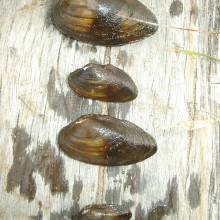
Scientists mussel-in on sticky surfaces
US reseachers studying how mussels anchor themselves to rocks, stones and jetties have stumbled upon a trick that can chemically coat any surface with something so sticky that it will even bind to Teflon.
 When Phillip Messersmith and his team at Northwestern University analysed the mussel glue they found it to be very rich in a chemical called DOPA (di-hydroxy phenylalanine), together with an amino acid building block called lysine. These two molecules interact to give the glue its sticking power. So the researchers wondered whether other molecules, containing the same chemical groups, might behave in the same way when exposed to seawater. To find out, they used the substance dopamine, which is used in the body as a nerve transmitter but also contains both a catechol group, like DOPA, and an amino group, like lysine. Incredibly, the trick worked. When a small amount of dopamine was dissolved in water and then the water was made slightly alkaline like the sea, the dopamine molecules linked up to form polymers. If an object was added to the solution as this process was taking place an ultrathin layer of the polymer just 50nm thick (1000 times thinner than a human hair) was deposited on the surface, which then behaved as a "key" to which other substances could be attached. By dipping treated objects into a solution containing copper or silver ions it was possible to metal plate the material, producing electrically conductive plastics.
When Phillip Messersmith and his team at Northwestern University analysed the mussel glue they found it to be very rich in a chemical called DOPA (di-hydroxy phenylalanine), together with an amino acid building block called lysine. These two molecules interact to give the glue its sticking power. So the researchers wondered whether other molecules, containing the same chemical groups, might behave in the same way when exposed to seawater. To find out, they used the substance dopamine, which is used in the body as a nerve transmitter but also contains both a catechol group, like DOPA, and an amino group, like lysine. Incredibly, the trick worked. When a small amount of dopamine was dissolved in water and then the water was made slightly alkaline like the sea, the dopamine molecules linked up to form polymers. If an object was added to the solution as this process was taking place an ultrathin layer of the polymer just 50nm thick (1000 times thinner than a human hair) was deposited on the surface, which then behaved as a "key" to which other substances could be attached. By dipping treated objects into a solution containing copper or silver ions it was possible to metal plate the material, producing electrically conductive plastics.
The team hope that the discovery will make it possible to produce body implants and medical implants, such as silver-coated catheters, which have anti-bacterial qualities. It has even been possible to use the technique to remove heavy metal contamination from drinking water.
"We were able to remove mercury from water by passing it down a column containing beads treated with our polydopamine coating," says Messersmith. "So this could be very useful in cleaning up water in countries with heavy metal pollution."
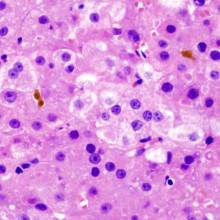
06:20 - RNA-away Hepatitis
RNA-away Hepatitis
Scientists in the US have uncovered how the body tackles certain viral infections, and the results might help to produce better ways to treat Hepatitis C.
Hepatitis C is a blood-bourne viral infection spread by needle sharing, use of contaminated blood products and by sex, and it affects about 1% of the population in the western world; 80% of individuals who catch it develop a chronic infection which causes liver injury and can lead to cirrhosis in about 20% of cases.
Recently, doctors have found that long-term therapy with a immune-regulating hormone called alpha-interferon can enable the immune system to overcome the virus and eliminate it from the body, although exactly how remained a mystery.
Now, writing in Nature, UC San Diego's Michael David and his colleagues have uncovered the mechanism, and in the process revealed a previously unknown mechanism by which the body deals with viral infections.
The team treated cultured cells with interferon and then studied the levels of short pieces of genetic material called micro RNAs, which have in recent years been shown to play key roles in regulating gene activity. Using this technique the researchers pinpointed 30 different micro RNAs that altered their levels in the presence of interferon.
They then compared these RNA sequences with the hepatitis C genome to see if there were any matches. What they were looking for were sequences in the virus that were mirror images of the micro-RNA because when this happens the micro-RNA can bind to its mirror image viral gene and disable it.
The researchers discovered 8 micro RNAs (miRNAs) that were direct hits in the hepatitis C genome.
To find out whether they could affect the growth of the virus they added synthetic versions of each of the micro RNAs to hepatitis C infected cells, which reduced the turnover of the virus in the cells by 70%.
This approach could hold the key to effective new therapies for hepatitis C in the future, and may also spare patients the unpleasant flu-like side effects of interferon therapy.

09:26 - When you've got to go...
When you've got to go...
Scientists in Belgium have found a gene that may be partly responsible for the urge to spend a penny...
Normally, when our bladder gets full, then this sends signals to the muscles around it telling them to contract, meaning a trip to the toilet is in order.
Bernd Nilius and his team have found that if a gene called TRPV4 is faulty in mice, then they become incontinent. This means that they no longer have that level of control over their bladder muscles, and just go all the time. The researchers also looked at bladders taken from mice with the faulty gene, and found that they sent smaller chemical signals telling the muscles to contract, compared with bladder from mice with an intact version of TRPV4.
The TRPV4 gene makes a protein that sits in the wall of cells that line the bladder, and helps to send signals that tell the bladder muscles to contract. The researchers think that it has an important role in translating the signals that the bladder is full into muscle contraction that allows a controlled trip to the loo. Although these are just experiments in mice, there is the possibility that TRPV4 might be a target for treatments to help with bladder problems such as incontinence.

Researchers get to the bottom of coral clock
Working on the Great Barrier Reef, researchers at the University of Queensland in Australia have lifted the lid on one of the great marine mysteries of our time - how corals synchronise their spawning and ensure that it takes place on just a few nights of the year and always when there is a full moon.
 Writing in this week's Science, Oren Levy and his colleagues describe how they have found the coral equivalent of the human body clock in the larvae of reef building coral (Acropora millepora). The team probed the coral DNA for sequences similar to genes called CRY - short for cryptochrome - which are used to power the body clocks, and in some cases directly detect light, in flies, worms and mammals. Using this approach the team successfully identified two coral CRY genes, and then went on to measure the activity of the genes at different times of the day and night.
Writing in this week's Science, Oren Levy and his colleagues describe how they have found the coral equivalent of the human body clock in the larvae of reef building coral (Acropora millepora). The team probed the coral DNA for sequences similar to genes called CRY - short for cryptochrome - which are used to power the body clocks, and in some cases directly detect light, in flies, worms and mammals. Using this approach the team successfully identified two coral CRY genes, and then went on to measure the activity of the genes at different times of the day and night.
They found that the genes encode proteins which respond to blue-green light, which fits perfectly because water absorbs red light very strongly. Then, by growing coral samples in tanks with either a normal light-dark cycle to simulate day and night, or by keeping the coral just in the dark for an extended period, the team found that the levels of the genes peaked in the daylight and dropped off in the dark. Next they collected RNA samples from corals on the reef when there was a full moon, and again when there was a new moon (i.e. no moon) and compared the levels of the two genes. Intriguingly at the time of the full moon the levels of one of the genes - cry2 - were much higher, suggesting that this gene is the linchpin which links the coral's behaviour to moonlight and therefore the spawning pattern.
"It's very complex and we don't yet know what the other factors are that regulate the process," says Levy. "For instance, it's one things knowing that the time is right, but how does the coral know to spawn simultaneously with other corals? My guess is it will take another couple of years to understand how it all fits together."
Do astronauts change their diet before they head off into space?
In the early days NASA did worry about astronauts' diets and going up into space for various reasons. One is that if you have gut flora or bacteria that break foods down into gas: if you eat foods that they like breaking down and turning into gas, then there's a worry that you could end up making a lot of gas and that could be quite unpleasant in your spacesuit. That was the theory, so diets were selected to be what's called, 'low residue,' and fairly stomach-kind.But in fact experience has shown that, after many, many space missions that's probably not necessary. So you can go for pretty much anything that can be desiccated down to dried-out astronaut food.

What's the science behind fire-walking?
There's no trick to it necessarily. It's not entirely what it looks like. Basically there are three components. The first thing to consider is that when you're walking across fire, understandably, you do it a bit quickly. So you're actually minimising the time that any particular part of your body is in contact with the fire. This is the same reason that lizards scoot about in the desert on hot rocks. The quicker they move, the less they're going to burn themselves. There are two other things: the fires are lit and left to burn until they become like a barbecue. The top layer of that is ash. Ash is actually a pretty good insulator against the direct heat underneath. So you can feel the heat above it but the burning heat won't get through so much. Also carbon is the component of the coals. Carbon is a very poor conductor of heat so the burning at the bottom of the fire pit won't come up so much. So it's not as hot as it looks and also you go across it very fast.There is another theory that because you're a bit nervous, just as you would get sweaty hands, your feet sweat a bit and you effectively surf across the top of the coals on a cushion of steam which also helps to keep the temperature down.
What is the reason for paralysis?
It can be both because the spinal cord isn't just a one-way street. It's got information coming out of the brain, down to what we call motor neurons, the motor nerves that supply your muscles. At the same time information's coming in from your body, going up the spinal column, into your brain, telling your brain where your body is in space, how fast different muscle groups are moving and where they are and whether the movement you're just made has been completed. So if you've damaged the spinal cord you can damage just the sensory fibres and that means you can't feel your body but you could potentially still move. You can damage just the motor fibres which means although you can feel your body you can't make any movements. More usually it's impossible to be that discrete when you make a lesion in the spinal cord. For example, people dive into the swimming pool where it's too shallow and they impact on their neck. They break their neck, it severs the spinal cord and it disjoints all of the fibres coming up from the body: telling your brain what your body is doing/what it feels like, as well as the fibres coming out of your brain that tell you muscles to move. This means you can't feel your body nor make it move, so it's very unpleasant.
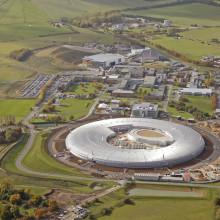
20:41 - The Brightest Diamond; Synchrotron, that is...
The Brightest Diamond; Synchrotron, that is...
with Richard Walker & Sanjeet Dhesi, Diamond Synchrotron; Tim Wess, Cardiff University
Earlier this week, HM the Queen and the Duke of Edinburgh opened the Diamond Synchrotron in Oxfordshire. Now this very expensive device creates very high energy electromagnetic radiation (that's known as synchrotronic light) and it's filtered to give you and extremely intense x-ray beam which is hundreds of times more powerful that the one you'd get in hospital. We sent Meera down to the site this week to find out how it works and the benefits of using such high-energy light.
Meera - Hello, this week I'm at Diamond Light-Source out at Didcot, Oxfordshire to find out about the giant particle accelerator located out here known as the synchrotron. Now the building itself is huge, silver and doughnut-shaped. And to give you an idea of just how big it is, it apparently covers the area of five football pitches. What I'm here to find out about is, 'what is a synchrotron, what does it actually do and how does it work?' I'm also going to be finding out just how this technology is being used to benefit everyday life and even to uncover ancient messages hidden in parchment such as the Dead Sea Scrolls. To answer the first of my questions is Richard Walker who's the Technical Director of Diamond Lightsource. We're actually here inside the synchrotron now. What exactly is a synchrotron?
 Richard - A synchrotron is a particle accelerator; in the case of Diamond we accelerate electrons. We accelerate these in a large circular machine, about half a kilometre in circumference where they reach very high energy. The energy is 3000 million volts and at that energy they give off very large amounts of electromagnetic radiation when they're bent to maintain their circular orbit. It is this electromagnetic energy, called synchrotron light that we use in the experiments.
Richard - A synchrotron is a particle accelerator; in the case of Diamond we accelerate electrons. We accelerate these in a large circular machine, about half a kilometre in circumference where they reach very high energy. The energy is 3000 million volts and at that energy they give off very large amounts of electromagnetic radiation when they're bent to maintain their circular orbit. It is this electromagnetic energy, called synchrotron light that we use in the experiments.
Meera - We're inside the synchrotron itself, where are we standing?
Richard - Well, we're actually stood in the linear accelerator which is the first part of the acceleration system. Right at the beginning, where the electrons come to life and they're liberated from the atoms in an electron gun. The electron gun fires the electrons into the linear accelerator where they're accelerated up to 100 million volts. From there they're transferred into another synchrotron, a booster synchrotron where they're accelerated up to the final energy of 3000 million volts before they're injected into the storage ring.
Meera - They're bent round. Is this done using magnets?
Richard - We use a large array of electromagnets, both to bend the electrons that form the circular orbit and also to focus them and keep them very tightly compressed. It's the small size of the electron beam that gives rise to very bright synchrotron light that we want to generate and use in our experiments.
Meera - So now I know how the synchrotron actually runs, but what benefit does this high beam of light actually provide? I'm with Sanjeet Dhesi who's a principle beam-line scientist here at Diamond. What, exactly, is a beam-line?
Sanjeet - A beam-line is a series of x-ray optics that helps channel the light that's produced in the machine all the way down to the sample where we have an electron microscope that we use to study anything from magnetism to chemical reactions on a surface.
Meera - So we're outside your nano-science beam-line now. What is this in front of us? How is this beam line being channelled?
Sanjeet - If you take light into a camera you use a series of lenses to focus the light onto your film. If you try to do that with x-rays, the x-rays just go straight through the lens. Instead of using lenses you have to use mirrors. The beam-line is actually a series of half a dozen mirrors that take the light and channel the light and focus the light down to our sample where the light is only a tenth of the width of your hair but it has about 1000 billion times the intensity of a hospital x-ray source.
Meera - How many beam-lines are there here at Diamond?
Sanjeet - In phase 1 of Diamond there were seven beam-lines that were constructed. You can do anything on a beam-line from looking at the structure of a protein to understand how a virus attacks your body to looking at structures under extremely high pressure and extremely high temperatures. That's important, for instance, for understanding how iron behaves at the Earth's core. There's a whole host of ways that x-rays interact with matter to work out exactly what's happening at the fundamental level of the atomic scale.
Meera - So extremely variable fields of science are being explored using this synchrotron light but it's not only science that's benefiting. Scientists are also trying to learn more about history. Professor Tim Wess and his team at Cardiff University have been using synchrotron light to understand the texts of ancient parchments such as the Dead Sea Scrolls: potentially enabling them to read the scrolls without having to unravel them. I've got Tim here with me now. Hello Tim.
Tim - Hello Meera.
Meera - What made you start working with ancient parchments?
Tim - Well, what a lot of people don't actually know is that parchment's actually made out of dried skin and therefore that's made out of collagen. I've been working with synchrotron radiation to understand the structure of collagen for about the last 20 years. What we've been trying to do is see how intact the collagen is in a piece of parchment because what happens to parchment as it gets older and the control mechanisms of repair are lost when we're looking at something which is no longer in an animal, you begin to see that the collagen deteriorates into gelatine. Collagen is really like a little rope molecule which really gives us the strength in our tissues, tendons, our bones and our skin. When it deteriorates into gelatine usually in our body it's taken away and recycled but in a document like an historical parchment the gelatine just sits there. It's lost its strength; it likes to take up water which means the gelatine actually becomes a jelly. Therefore, the parchment becomes very fragile, brittle and very, very difficult to unfold and read or handle.
Meera - So how are you using synchrotron light to overcome this problem?
Tim - First of all, we can begin to detect without hopefully damaging the piece of parchment how intact it is. Using the synchrotron, we have a very fine beam of x-rays we put through the parchment sample. The way that the x-rays interact with the matter tells us about the state of the matter that's present. We get a very distinct signal for the way the x-rays are scattered with collagen and a different one for gelatine. We can begin to tell the difference between those two and then advise on the collagen-to-gelatine ratio in any of these samples. We have looked at the Dead Sea Scrolls here using the scattering to try and understand the damage that's occurred to the Dead Sea Scrolls because what we're finding is that the caves that the different samples were coming from seem to have affected how stable they are and how they've managed to stay intact. When we find that a sample has been so badly damaged that it shouldn't be displayed or unfurled, there's a second approach with the synchrotron that we can begin to use which really relates to a process called tomography. We pass an x-ray beam through an object then the picture we get depends on presence of things like writing on the surface of the parchment so from that we can take lots and lots of pictures at different angles of the piece of parchment. Whether it's a rolled up piece of parchment as a scroll, we can then reconstruct on a computer from all the different absorption patterns that we have what the original object was. And that's where we've begun to realise that using the ink on parchment, on the surface of it, we can read objects which we would really not be able to unroll.
Meera - So there you have it. Irony at its best. This giant silver doughnut is enabling scientists to probe matter down to tiny atomic scales and this extremely new technology is going to provide answers to questions and beliefs that go back thousands of years.
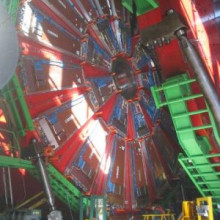
29:13 - Inside the Atom
Inside the Atom
with Dr Ben Allanach, Cambridge University
Chris - We're looking at the origins of the universe, what's inside matter, what are atoms made of this week. Let's kick off by talking first of all to Ben Allanach, a theoretical physicist at the University of Cambridge. So when we're talking about atoms I think even the ancient Greeks (sort of Democritus' time) had a concept of the atom, as this tiny particle which you can link lots together and you've got something. How do we actually know what's inside them?
Ben - A hundred years ago Earnest Rutherford, down in the Cavendish lab, here in Cambridge fired radioactive particles into atoms and you can tell from that roughly speaking what's going on inside. One in about every eight thousand of these particles came back at him. He measured those with a Geiger-Counter. That led him to completely throw away the model at the time which was the 'plum pudding' model of some sort of squishy stuff which was positive with little electrons dotted around it. What he realised was that most of the atom is actually empty space, with light electrons flying around the outside. Inside there's a very small, hard, dense core called the nucleus.
Chris - It's interesting, what you say about the empty space Ben, I've got an email here from Jack Dao who says, 'Hi guys I'm listening in Brooklyn, New York and I like your program. I've heard there's a vast empty space between the orbiting electrons and the nucleus of an atom but I've been told that if all the empty space was taken away so that every single electron touched another electron and the nucleus then the size of the world would theoretically be the size of a melon.
Ben - That could actually be true. I'd have to do a calculation on the back of an envelope to be absolutely sure but it is a huge amount of space and the particles inside are tiny.
Chris - What are the actual particles that make up an atom?
Ben - Around the outside you have electrons, they're light, negatively charged particles and inside you have the nucleus which is made up of protons and neutrons. They're kind of heavier stuff that stick together quite well.
Chris - And how big are these things?
Ben - An atom is roughly 10-10m so that's a tenth of a billionth of a metre across and the tiny constituents in the middle are almost a million times smaller than that so they're just unimaginably tiny really.
Chris - And the nucleus is positively charged because it's got the protons in it and the electrons are negatively charged. Now I can understand why the electrons would be clung-on to by the positive core of each atom. Why is it that all those protons with that big positive charge can be stuffed together and they stay there? They don't fly apart...
Ben - There's an additional force keeping them together that's called the strong nuclear force. They're stuck in there with neutrons as well and this thing just sticks them together.
Chris - And so how do we work out what the different atoms are because if I've got an atom of oxygen which I'm breathing, how is that different from say the atom of carbon that I'm burning to make the energy in my body?
Ben - You can weigh them through indirect means and you can work it out through chemical reactions and so on to work out how many of the different atoms make different substances up.
Kat - Delving a bit more deeply into the structure of matter, you hear about things like quarks and neutrinos and all these kinds of things. How do they fit in and how do we know that they're there?
Ben - Well, as far as we know they're the smallest bits of matter and so if we go deeper into the nucleus, for instance, every proton and neutron is made up of three smaller particles and they're quarks. They're stuck together with this strong nuclear force so by breaking up protons you can actually detect these things indirectly.
 Kat - This is where things like particle accelerators come in?
Kat - This is where things like particle accelerators come in?
Ben - That's right yeah. So Rutherford's initial experiments of the radioactive atom are now being done at much higher energies in order to delve deeper and deeper into the protons.
Kat - So tell us a bit more about what you're doing. I sort of understand it as you do the maths and then the particle accelerator people try and work out if it's right or not.
Ben - Yeah, it gets a blurred around the edges though. We both do bits of each other's jobs. That's right, I do a lot of theory and there's a lot of sums. I try and work out models of the early universe to explain facts about the universe that you see today and then most importantly, to work out ways of testing these theories by looking at the data coming out of the experiments.
Kat - So this is working out what you should see if you smash two particles together?
Ben - If the theory is right, yeah.
Chris - So why do you want to smash things together? How does that actually help?
Ben - Because we can't actually see with the naked eye or even with a microscope we can't actually see these particles. They're much too small so the only way to probe them at all is to have something very high in energy that breaks them apart and you can see what they decay into, for instance. You can get a picture of what happens after those collisions. That's the only way you have, really, of probing them.
Chris - What's new about the large hadron collider? What have we done in the past and how does this differ?
Ben - Plenty of different collisions have been happening in the past and basically the energy gets higher and higher and higher every time. In Einstein's equation E=MC2, if you're got more energy you can make heavier particles. So particles that were previously undiscovered, when you pass an energy threshold, all of a sudden you'll be able to produce them. That's what's hoped particularly for the Higgs boson hypothetical particle that's hoped will show up there.
Chris - So up until now people have been slamming things together the same way as they will do in the LHC but now they're gonna be able to do it even more powerfully?
Ben - Yeah, basically that's right. The technology's come on a lot and that's why they're able now to do such high energy collisions.
Kat - Where's this gonna stop? If we've got this new, exciting, huge particle accelerator, what if you do some sums you'll find some evidence that means you'll have to build an even bigger one to get even higher energies? Do you think that the LHC would be the answer to everything?
Ben - Not necessarily. You might need to build one more, actually.
Kat - An even bigger one?
Ben - Well, it won't necessarily be bigger.
Chris - Don't these things consume energy on the scale of a national grid just for one experiment?
Ben - It's not as much as that, actually. It is a lot of power, its 100MW or so.
Chris - That's about 20% of a reasonable nuclear power station. So that's quite a lot isn't it?
Ben - It's a lot of power so you do have to weigh up the cost of these things and decide whether the science you're gonna get out of it is actually worth the cost. It was decided, and I think rightly, that for the LHC, the answer to that question is yes. It will be that that decides whether the next one is built.
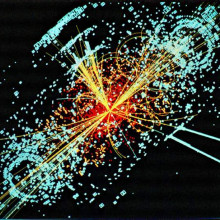
36:44 - The Search for Sub-Atomic Beauty
The Search for Sub-Atomic Beauty
with Dr Cristina Lazzeroni, Birmingham University
Chris - Now we've heard from Ben Allanach about some of these collisions and the huge energy that are going to be produced. Presumably from those collisions there are particles produced or evidence that particles get produced so we can try and understand what's inside atoms. What are you actually looking for in your experiments?
 Cristina - That's right, we try to collide two protons together in this case, accelerated to about the speed of light. The fact that they have this huge energy will make it possible to produce heavy particles and particles that were never seen except at the very beginning of the universe. That's what we're trying to find, essentially new particles that we were not able to see before because we didn't have enough energy.
Cristina - That's right, we try to collide two protons together in this case, accelerated to about the speed of light. The fact that they have this huge energy will make it possible to produce heavy particles and particles that were never seen except at the very beginning of the universe. That's what we're trying to find, essentially new particles that we were not able to see before because we didn't have enough energy.
Chris - So what you're trying to do is to simulate, in a laboratory environment, the Big Bang?
Cristina - Kind of.
Chris - So you're turning a pinpoint of energy into the stuff, the matter that is the stuff we see around us today.
Cristina - Yes, that's quite the idea, yes.
Chris - I guess the question is though, is that safe? Are we going to spawn a new universe in CERN in Geneva where people do say it's the centre of the universe in some respects but is that a good idea?
Cristina - Yes it is actually, it's a very good idea and no, we are not creating an entire universe. Previously, for example in CERN, we have been smashing particles together for years. In fact, CERN has been celebrating its 50th year quite recently. Nothing of such catastrophe ever happened. There are reasons for that. The idea that we've got higher and higher energy is because we want somehow to go more and more back in time. We want to see the particles that were produced farther back in time. That doesn't mean that it's dangerous because these particles live so shortly and is not dangerous in itself that there will be no harm for anybody.
Chris - How can you really have faith that you've recreated what was going on at the Big Bang?
Cristina - Let's be honest, we will not create the exact condition of the Big Bang but what we want to do is to get a very similar condition as much as we can. That doesn't matter if it's not a perfect condition to try to understand how these particles were formed and the new particles that may come over and try to build more complete pictures from that.
Chris - So, theorising for a minute and straying into Ben's territory - what do you think actually happened then, when the universe was born? There was a lot of energy around then so can you just talk us through what you think, on paper at least, probably happened?
Cristina - Right, yes at the very beginning we think that there was a new state of matter which is called Plasma. This, in fact is one of the main topics of one of the experiments at LHC. You know that in quarks, quarks are confined in protons and neutrons so in fact we never see quarks free so far. We see protons and neutrons but not quarks. We believed at the very beginning there was such a hot and dense state of matter that the quarks were actually free. So it's all together some sort of big, hot and dense soup of quarks and gluons. From there the things started to freeze out and our model has to be somehow the kinds of studies that we do with gases and with liquid, that sort of thing. At some point somehow matter formed as atoms. Also light was released and went out forever. That is what we observed. From atoms we got bigger matter and so on.
Chris - So when you designed an experiment for the LHC as it will be, when it switches on next week in CERN, what's going to be happening is a stream of protons is gonna be whipping round this circle (27km long) at nearly the speed of light. Tremendously high energy and that beam will then be brought into collision course with a second beam going the other way. The two will then cannon into each other at a point, presumably you know where that collision will happen. So what are you looking for?
Cristina - At that point, in fact, there's going to be four places of collision along the ring. We place at these collision points some huge cameras. They take almost photographic pictures of what's going on. So from these pictures you try to use some sort of forensic science to go back and see from the traces that they left in the detector what was actually happening in the first collision.
Chris - That doesn't sound too complicated. The price tag is huge. How long are you going to have to do this for to see the kind of evidence that you need to know what's going on?
Cristina - Well, it depends what people are looking for. If you look for very rare processes, for things that you know are very, very rare you have to look for longer. There might be other things that you spot immediately. We hope to see the Higgs boson quite fast but, you know, you never know until you see it.
Chris - Ben mentioned it; you mentioned it. What is the Higgs boson?
Cristina - The Higgs boson is supposed to be the thing that gives everybody mass so we could imagine it's a sort of gelatine that fills the space. The bigger you are the bigger resistance this gelatine offers to you. So somehow the Higgs mass is this sort of gelatine that fills up the entire space. Somehow it gives you more mass because it gives you a measure of the resistance that you have going through it.
Chris - So this is what Ben tells us should exist?
Cristina - If it doesn't exist in fact, the whole theory needs to be revised quite fundamentally, yes.
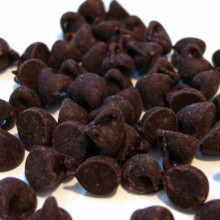
43:19 - Choc Chips Survive Baking?
Choc Chips Survive Baking?
We also received a related question:
"Hello, this is Simon Griffiths from Brisbane, Australia. I have an interesting question for the Naked Scientists. Why don't Cadbury's Flakes melt? I've tried microwaving and double-boiling with no luck. And I though it would be a tasty experiment for the Naked Scientists."
Diana: So we have several issues here - one of them is that cooking chocolate has different melting properties to ordinary chocolate:Stephen: Hi my names Stephen Euston. I'm a Food Scientist in the School of Food Science at the Herriot Watt University. I've been asked to talk about the reasons why chocolate melts at different temperatures. When you make chocolate you roast cocoa beans to extract something called chocolate liquor. To make eating chocolate from that you normally add extra fat, cocoa butter, and that reduces the melting point of chocolate so that it becomes closer to body temperature. So it melts in your mouth when you eat it. With baking chocolate you don't add extra fat and that gives it its higher melting point. Diana: Then there's the special case of the Flake.Paul: Hello, my name's Paul Bidder, I'm an Independent Food Technologist and I've spent some time working in the confectionary industry. I think the explanation for this is that the distribution of fat within the Flake type of chocolate is different from normal chocolate. Basically, chocolate is a mixture of very tiny ground particles, sugar cocoa and milk solids. That's surrounded by the cocoa butter or cocoa fat. When the cocoa butter melts - if the fat is very well distributed it allows the fat to lubricate the individual particles and so they can slide over each other quite easily and that will give you a nice runny chocolate. If, on the other hand the fat within the chocolate isn't as well distributed the particles of chocolate won't slide over each other and not then give you a nice runny chocolate. It just happens that with the case of Flake, the manufacturing process is slightly different and the fat is not as well distributed as it would be in the case of ordinary chocolate.Diana: But how do chocolate chips stay chip-y in biscuits and cakes?Paul: This is slightly different, I think from the situation of the Flake in that, when chocolate does melt it doesn't melt in exactly the same was as an ice cube would do if you heat it up. If you melt chocolate without applying any force to it, it actually tends to retain its shape and that's because of the structure of all the particles that are there within the matrix of the fat. The biscuit around it provides enough support for the chocolate chip to remain chip-shaped through the baking process. Diana: And why might cooking permanently change chocolate after it has reset?Paul: It may be that during the baking process, the fat distributes itself around within the chocolate chip a little bit more effectively and so perhaps will melt a little bit easier. A more likely explanation is that the fat within the chocolate chip becomes mixed with some of the fat from the biscuit and when you get two different types of fat mixing together the actual physical effect is that it reduces the melting point of fat mixture and that may account for why the chocolate, after it has been baked appears to melt easier than the uncooked chocolate chip.Diana: So to sum up: don't cook with flakes and watch out for those cocoa fat matrices, because the wrong sort can make you very sticky!
Could scientists potentially make black holes in the lab?
We put this question to Cristina Lazzeroni, Particle Physicist from Birmingham University:Cristina: Yes, we would like to make black holes with the large atom collider. It would be very interesting because there are lots of things we don't know about them and we could study them. And no they would not destroy the entire universe because they would be very, very localised and they would last such a short time they would not destroy anything. Chris: Why wouldn't they grow huge?Cristina: Because they will decay and die instantaneously like anything else.
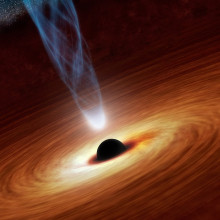
Could there exist white holes as a counterpart to black holes?
We put this question to Ben Allanach, Theoretical Physicist from Cambridge UniversityBen: They're are theoretical possibility as you can find out from solving Einstein's equations but if you actually look into them you can't really see how they would form. They seem to be unstable. They're like black holes but stuff comes out of them rather than the other way around. Chris: So they're the reverse?Ben: YeahChris: So would the stuff that came out be antimatter? Because in our universe all the stuff we can see is matter.Ben: It would be any matter and antimatter and light would come out. They're unstable so I don't think they can form.
- Previous Stem Cells and Cloning
- Next Naked Science Q&A Show
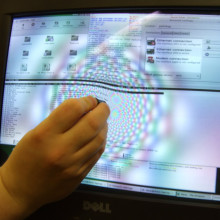










Comments
Add a comment